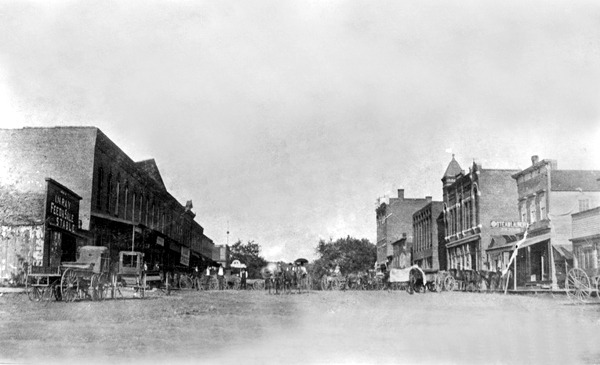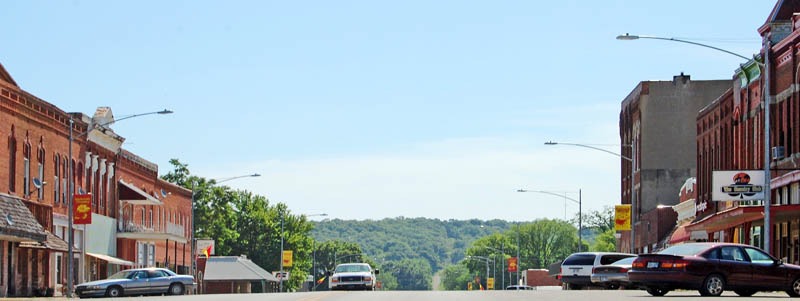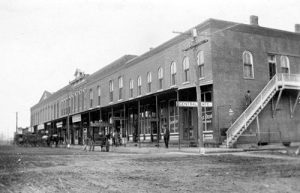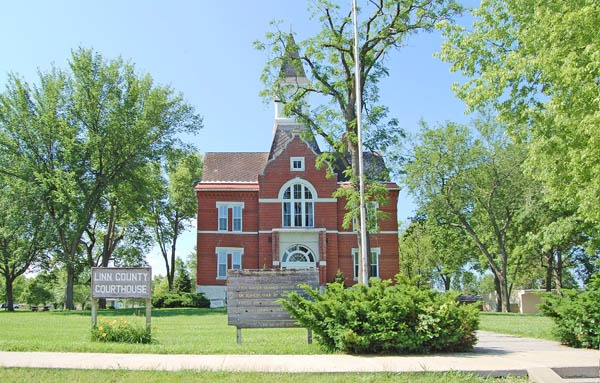Mound City is the most picturesque town in the state. It nestles close under the shelter of Sugar Mound, which extends in the form of a crescent around the east and south sides of the town. Beautiful wooded hills are to be seen in every direction, with fertile valleys and winding streams between. On those hills grow thousands of hard and sugar maple trees. He, who had not visited this quaint old town in the fall of the year after the frost kissed the leaves of these sugar trees, causing them to blush as with maiden modesty, had not seen the real beauty spot of Kansas.
— J.T. Botkin
Situated south of the center of the county, Mound City is the county seat of Linn County. It was first called Sugar Mound due to its proximity to the mound of the same name, situated a little to the east. One of the first businesses established was a grocery store owned by a pro-slavery man named Miller. On March 15, 1855, a post office was established, with the first postmaster being Dr. Isaac B. Stockton.
The townsite of Mound City was located by D.W. Cannon and Ebenezer Barnes in 1855, but wasn’t officially organized until 1857. The townsite, consisting of 240 acres, was surveyed by N.J. Roscoe the same year, and the first building, a log cabin, was erected by William Wilson. In the spring of 1857, Dr. J.H. Trego, Edwin, and T.E. Smith moved into the vicinity of Mound City and erected a sawmill on Little Sugar Creek by the following fall. The following structure was a frame building erected by Charles Barnes in January 1858. It was occupied as a store and, later, a post office. A few months later, James F. Matheny completed a boarding house; in April, Edwin Smith and Dr. Trego each completed their homes; in June, T. E. Smith completed his first three frame residences erected. In the summer, W.H. Barnes started the first blacksmith shop. By 1858, the settlement sported a doctor and two lawyers.
A large Fourth of July celebration was held at Sugar Mound in the summer of 1858, with at least 1,000 people attending, many from miles away. A grand barbecue was the notable feature of the celebration, but the roasted ox proved too small to feed all the people who attended. That summer, a Town Hall was erected, and in the winter of 1858-59, it also served as a school with a man named A. A. Johns as the first teacher.
Though these early years proved successful for the fledgling city, Mound City and Linn County were immersed in the Kansas-Missouri Border War as pro-slavery men and abolitionists fought for control of the territory. During these tumultuous years, Mound City and its vicinity became the headquarters of Charles R. Jennison, the leader of the Kansas “Jayhawkers” and Free-State advocate James Montgomery. Many area citizens rode with these leaders on their forays against the Missourians. Jennison was the first to become established in the town, and his name became a terror to the people of Bates and Vernon Counties in Missouri. Mound City was used as a base from which to strike quickly and get back across the border before the citizens of Missouri could gather a force and strike back. In December 1860, an infantry company under Captain National Lyon came to Mound City with orders to capture Captain Montgomery, who lived about five miles up Sugar Creek. When the company arrived, Montgomery, who had been notified, was gone.
On February 1, 1859, the former post office on Sugar Mound was moved to the new townsite, which officially became Mound City. The Linn County Herald, the first paper published in Linn County, was started at Mound City on April 1, 1859, by Jonathan Lyman. However, after being published for just one year, the name was changed to the Mound City Report, and J. F. Broadhead became the editor. In the spring of 1861, R. B. Mitchell bought the press, moved it to Mansfield, and started the Mansfield Shield and Banner.
On November 8, 1859, an election was held in the county to determine the permanent location of the county seat. Paris and Mound City were the principal contestants, with Mound City receiving a majority of the votes, 508 to Paris 471. At least for a time, Mound City was officially declared the seat of justice. It would move several times over the next 15 years before settling for the last time, once again in Mound City in 1875.
In 1863, the United Brethren congregation began to build a church, but could not finish it due to financial constraints. They then sold the building to the Ladies’ Enterprise Association, which completed it and converted it into a free church and schoolhouse. Later, in 1866, the building was acquired by the county and used as a courthouse.
On April 1, 1864, J.T. and J.D. Snoddy established another newspaper, the Border Sentinel. Though J.T. Snoddy died on the 21st of the same month, J.D. Snoddy continued the newspaper’s publication for a time. In August 1866, the newspaper was sold to Joel Moody, who would publish it until March 28, 1868, when he sold it to Nathan G. Barter. Barter continued its publication until January 1874, when it was removed to Fort Scott.
The Baptists built a substantial brick church in 1867, and the Congregationalists built a frame structure the same year. Though a Methodist Church was organized earlier, the congregation didn’t have a building until 1870, when a neat frame structure was erected.

Mound City in about 1873.
On April 1, 1873, J.J. McCallum established another newspaper, the Linn County Enterprise. It was sold in January 1876, and the name changed to the Linn County Clarion, which would continue for several years. In 1893, it was consolidated with the La Cygne Weekly Journal and called the Journal-Clarion until it was discontinued in January 1914.
On March 9, 1875, Mound City finally became the permanent county seat of Linn County. By the early 1880s, Mound City boasted three general stores, two hardware stores, two drug stores, four blacksmith shops, three carpenter shops, three hotels, two wagon shops, a stove and tin shop, a grocery store, bank, lumberyard, furniture store, a good stone schoolhouse, and a population of about 500 people.
In May 1885, construction began on the Linn County Courthouse, which was completed in late 1886. Designed in the American Queen Ann style of architecture, it was first occupied on January 1, 1887. The red bricks were made west of Mound City at the Smith & Mitchell Brick Plant, and the limestone for the window and door sills, caps, and ornamental trim came from the Curry Quarry southwest of Mound City. Over the years, the building was updated, but its structure changed very little. The building was placed on the National Register of Historic Places in 1974 and is the second-oldest courthouse still in use in Kansas.
By 1910, Mound City, situated on the Missouri Pacific Railroad, boasted several fine stores, blacksmith and wagon shops, a good hotel, public schools, churches, a creamery, a flour mill, stone quarries, and a population of 698. Located in an affluent agricultural district, it had become a shipping point for grain, livestock, flour, and produce. During the 20th Century, Mound City remained a small agricultural community and never grew very large. Though other communities, such as La Cygne and Pleasanton, gained a higher population, Mound City has remained the county seat for more than a century and has preserved much of the history of the community, as well as Linn County. Today, Mound City’s population is about 700 people.
Mound City provides several historic views of its past at the Mound City Historic Park, with 11 structures, many of which have been moved from various locations in Linn County. The structures contain artifacts that tell stories of Linn County from the 1840s to 1950. It is located at 700 Main Street. The Old Linn County Jail and City Hall, listed on the National Register of Historic Places in 1978, stands at 312 Main Street, and the historic Linn County Courthouse sits at Fourth and Main. The Mine Creek Battlefield site is five miles east of Kansas Highway 52.
More Information:
Mound City
913-795-2220
©Kathy Alexander/Legends of Kansas, updated August 2025.
Also See:
Kansas Civil War Participation
See Sources.




